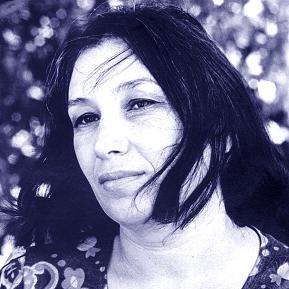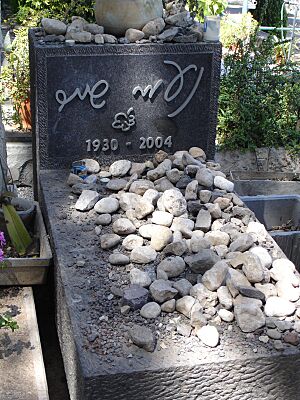Naomi Shemer facts for kids
Quick facts for kids
Naomi Shemer
|
|
|---|---|
 |
|
| Background information | |
| Birth name | Naomi Sapir |
| Born | July 13, 1930 Kvutzat Kinneret, British Mandate of Palestine (now Israel) |
| Died | June 26, 2004 (aged 73) Tel Aviv, Israel |
| Genres | World, Israeli Folk |
| Occupation(s) | Musician, songwriter |
| Instruments | Vocals, piano |
Naomi Shemer (Hebrew: נעמי שמר; July 13, 1930 – June 26, 2004) was a very important Israeli musician and songwriter. She was known as the "first lady of Israeli song and poetry." Her famous song "Yerushalayim Shel Zahav" ("Jerusalem of Gold"), written in 1967, became like a second national song for Israel. This happened after Israel won the Six-Day War that year and Jerusalem became united again.
Early Life
Naomi Sapir was born on July 13, 1930. Her parents, Rivka and Meir Sapir, lived in Kvutzat Kinneret. This was a special type of community called a kibbutz that her parents helped start. It was located by the Sea of Galilee.
In the 1950s, Naomi served in the Israeli Defense Force's Nahal entertainment group. She also studied music at the Rubin Academy in Jerusalem. She continued her music studies in Tel Aviv with famous teachers like Paul Ben-Haim and Josef Tal.
Songwriting Career
Naomi Shemer was special because she wrote both the words and the music for her songs. She also wrote music for famous poems by writers like Rachel from Israel and Walt Whitman from America. She even translated popular songs into Hebrew, such as "Let It Be" by the Beatles in 1973.
In 1963, she wrote "Hurshat Ha'Eucalyptus" ("The Eucalyptus Grove"). This song reminds people of Kvutzat Kinneret, where she grew up.
Her most famous song is "Yerushalayim Shel Zahav" (Jerusalem of Gold). She wrote this song in 1967 for the Israeli Music Festival. It was first sung by Shuli Natan and quickly became very popular. After Israel's victory in the Six-Day War that same year, Naomi added another verse to the song. This new part celebrated the reunification of Jerusalem. The song then became like a second national song for Israel.
Personal Life
Naomi Shemer first married an actor named Gideon Shemer. They had a daughter named Lali. Later, they divorced. Naomi then married Mordechai Horowitz, who was an attorney. They had a son named Ariel Horowitz, who also became a musician.

Naomi Shemer kept writing songs throughout her life. She passed away in 2004 from cancer, at the age of 73. Not long before she died, she told a friend something interesting. She said that she had used a folk melody from a place called Basque Country as the basis for her 1967 song, "Jerusalem of Gold." She had always said before that the melody was her own. Her friend and family decided to share this information. A singer named Paco Ibáñez had performed the Basque melody "Pello Joxepe" in Israel in 1962, so Naomi might have heard it then.
Naomi Shemer was buried in the cemetery at Kvutzat Kinneret, where she was born. Many important people who helped build Israel are also buried there. Naomi was buried close to the famous Israeli poet Rachel, which was her wish.
Awards and Legacy
In 1983, Naomi Shemer received the important Israel Prize. This award was given to her for her amazing contributions to Hebrew song, both for her words and her melodies. Her songs continue to be loved and sung by many people in Israel.
Works
Naomi Shemer wrote many songs and published several books of her work. Some of her well-known song collections include:
- All My Songs (Almost) (1967)
- The Second Book (1975)
- Number Three (Sefer Gimel) (1982)
- Book Four (Sefer Arbah) (1995)
See also
 In Spanish: Naomi Shemer para niños
In Spanish: Naomi Shemer para niños

